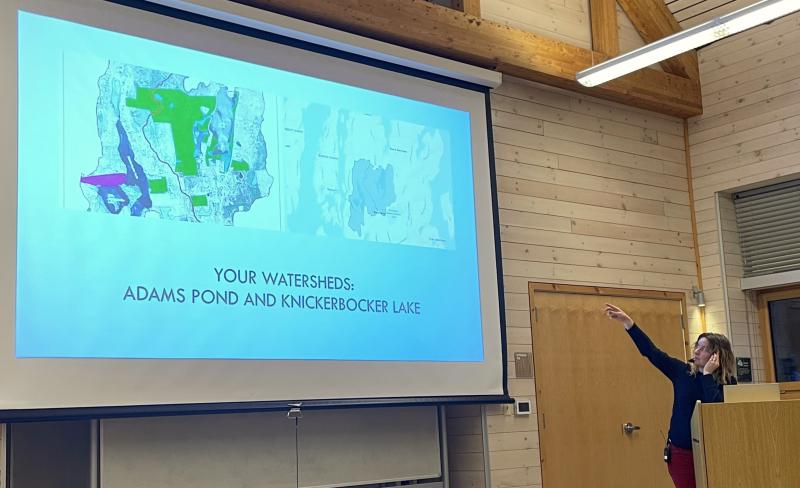How do we save watersheds, those areas where water drains into a common outlet? If you ask Rebecca Jacobs, program manager at Knox-Lincoln Soil & Water Conservation District, the answer is plants. That message resonated with the right audience when she spoke at Coastal Maine Botanical Gardens Feb. 28 about how watersheds work, why they are important and how to protect them.
“Everybody lives in a watershed,” Jacobs said. “No matter where the precipitation lands, it’s in a watershed. It's just a matter of topographically or geographically which watershed you live in.”
All runoff, including sediments and pollutants, eventually goes to a shared outlet. Jacobs said this means everyone impacts water quality, no matter if they get their water from a well or a water department.
“You're one piece of the larger puzzle, and you can't remove yourself from it because it all fits together,” she said. “We are all part of the watershed. So, you absolutely could live in the center of Boothbay Harbor on a small urban lot, by definition, and you are still part of the watershed, and what you do does impact the water quality.”
The backbone of the Boothbay region’s watershed, Knickerbocker Lake and Adams Pond, allows Boothbay Region Water District to service 3,300 connections and annually pump over 200 million gallons of water to Boothbay, Boothbay Harbor and Southport, according to the district. However, they are also on Maine Department of Environmental Protection’s threatened waterbody list.
Wetlands are a critical part of many watersheds, Jacobs said; and from 1780 to 1980, half the wetlands in the U.S. have been drained or altered, limiting critical wildlife habitats and pollution remediation.
“The wetlands are a part of our watershed that are the last stop for non-point solution,” she said. "They are nature’s opportunity to hold and retain pollutants and filter out the junk that we unintentionally or intentionally put into the environment.”
According to Jacobs, non-point pollution, pollution without a known source, is perhaps more concerning than point pollution, which can be traced; non-point pollution travels through the watershed, transported by runoff, and can include manure from farms, oil from roads and sediments from construction sites. She said both natural and human-caused erosion can compound pollution, transporting both sediment and the chemicals attached to it through the watershed.
But Jacobs explained property owners can protect the watershed they are in. They can limit erosion using special erosion control mulch rather than woodchips. She also explained the importance of maintaining walkways and driveways with proper ditching, grading and regular upkeep, especially after plowing season.
However, according to Jacobs, plants are some of the best watershed guardians. Vegetated buffer layers can mitigate runoff and erosion, limiting pollutants in lakes and rivers. Plants are also effective at infiltration, which sends water into the ground to be slowly dispersed rather than running across the surface. Vegetated ditches or rain gardens, loose soil mixed with water-infiltrating plants, can also effectively capture water with a relatively low amount of work and space. While constructed features like gravel traps can infiltrate, plants have evolved for it; the best have deep roots and stay alive year-round.
“With vegetation, you get infiltration, evaporation, you get soil retention,” she said. “Plants can filter out and hold, whether in the plant itself or in the soil itself, many of the pollutants that we are concerned about .... and the more vegetation you have, the slower, the longer, the less runoff you get to the lowest point, which is the nearby water source ... So, with vegetation, it's a win-win-win in every direction.”
In fact, Jacobs said research shows properly planned vegetation better protects shorelines from wave action than hardscaping does; hardscapes can redirect surging water to sensitive areas while vegetative zones can more easily absorb it. She said plants are also “immensely” cheaper because many constructed features require costly equipment, permitting and planning; this is especially true in shoreland zones, subject to intense storms like those in January.
“We've literally seen piers, docks, roads, all kinds of hardscape being ripped right up and moved away. And that's the whole cost to do it all again,” she said. “And when you have those vegetated buffers, more often than not, that water can go in and around and move through said landscape ... And you know even if the tree topples over, there's seeds within that soil structure that can re-sprout. It's a lot more forgiving.”
The talk was presented by the Clean Water Drinking Initiative as the first of a three-part series. The next talk, on Adams Pond and Knickerbocker Lake water quality, is March 5 at Bigelow Laboratory.
































